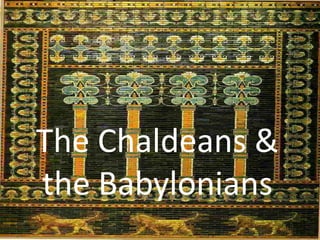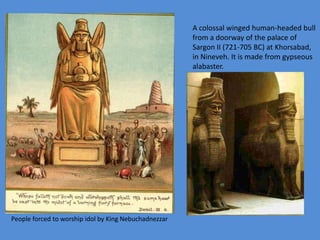The Chaldeans & The Babylonians
- 1. The Chaldeans & the Babylonians
- 2. Who are the Chaldeans? The Chaldeans of Beth Nahreen (Mesopotamia which is current days Iraq, east Syria, and south east Turkey) are a live continuation of all the indigenous people of Mesopotamia whether their tribal names were Sumerians, Akkadians, Amorites, Babylonians, Assyrians, Chaldeans, and Aramaeans. The language of the Chaldean people is Aramaic, a different dialect than that spoken by Jesus Christ.
- 3. The Assyrian EmpireThe Assyrian capital city: Nineveh
- 5. Assyrians known for brutality in warfare --only Mesopotamian civilization to submit to a queenBrutality of Assyrian art
- 6. Assyrian brutality produced hatred and rebellions among subjugated peoples
- 7. Sophisticated, far-sighted and effective military organization --invented concept of a corps of engineersThe defeat of the Assyrians and the destruction of NinevehMedes and Chaldeans defeat the Assyrians in 612 BCEMost famous Babylonian ruler was Nebuchadnezzar
- 9. The ChaldeansAs Assyria began to decline, the Chaldeans swooped in.Babylon, capital of their new empireNebuchadnezzar IIWarrior and builderHanging Gardens of BabylonChaldean culture Admired ancient Sumerian cultureDeveloped calendar; advances in astronomy
- 10. The Chaldean PeopleUr of the ChaldeansThe ancient Babylonian city of Ur became a chief city under Urgur. He was not only a conqueror but also a city builder.
- 11. Chaldeans :: Chaldee Women in ServitudeChaldeans :: Domestic Life and MannersChaldeans :: Chaldee WomanChaldeans :: Manners and CustomsChaldeans :: Chaldeans Trade with Arabia
- 12. EducationOnly the wealthiest boys were allowed to go to school and learn reading, writing and math. Girls weren't allowed.Schools were called edubba, they were also called tablet houses. School lasted from early morning until evening. They would write on clay tablets. They went to school for 12 years and the teachers severely disciplined students, sometimes they hit them with a stick. When they were finished school they became a scribe which was a high paying job.
- 13. Chaldean astrologers on the palace roof
- 14. A colossal winged human-headed bull from a doorway of the palace of Sargon II (721-705 BC) at Khorsabad, in Nineveh. It is made from gypseous alabaster.People forced to worship idol by King Nebuchadnezzar
- 15. This magnificent wall hanging was originally inspired by the glazed brick decoration of the famous Ishtar Gate which was constructed in Babylon around 575 BC on the instructions of King Nebuchadnezzar II. The gateway was covered with beautifully enamelled tiles and bricks in a glorious lapis lazuli blue; with its detail of dragons and bulls in brightly colored yellows and browns, which symbolised the gods of Marduk and Adad.
- 17. He was the oldest son of Nabopolassar, the Chaldean conqueror of the Assyrians and restorer of Babylonian independence. He reigned for forty three years (c.605-562 BC) and amassed a large empire in Mesopotamia. He was a very devout ruler (the Babylonian god Marduk was his chief deity) and he treated his captives humanely, unlike the cold blooded Assyrians. Many of the Jews that he exiled from Jerusalem were assimilated into the Babylonian culture and some rose to positions of relative power in the Court. The annals speak not so much of his military conquests but about his remarkable building programs.
- 18. The annals speak not so much of his military conquests but about his remarkable building programs.The City WallsThe Marduk ZigguratThe Hanging Gardens of Babylon
- 19. The City of Babylon
- 20. The Hanging Gardens ŌĆō One of the seven Wonders of the Worldhttp://sciencestage.com/v/207/ancient-world-history-babylon-seven-wonders-hanging-gardens.html
- 22. The AssyriansWar MachineAssyrian RuleFrom Northern Mesopotamia
- 23. Barley, cattle
- 25. New empire in 900 BC
- 26. Mesopotamia, Asia Minor, Egypt
- 28. War chariots, foot soldiers, cavalry
- 29. Masters of siege warfare
- 30. Terror
- 31. Efficient system
- 32. Local leaders
- 33. System of roads
- 35. Cultural achievements, libraryThe Assyrians and the ChaldeansAfter the Hittite empire fell, other peoples fought for dominance in western Asia. In time, the Assyrians became the supreme power in the region; later the Chaldeans formed their own empire.
- 36. Compare and ContrastHow were the Hittite, Assyrian, and Chaldean empires similar and different?Answer(s): All made cultural and technological advances. HittitesŌĆöknown for military power, efficient government.ChaldeansŌĆödeveloped calendar, Hanging Gardens of Babylon, short-lived empire. PhoeniciansŌĆönot an empire, built wealthy trading society, developed alphabet.
- 38. Modern Meggido in Israel, site of world history's first major battle
- 39. Nice view of Nineveh on the Tigris
- 40. The Ishtar Gate at Babylon
- 41. Chaldean FoodsBread Chaldeans & Babylonia. The bread was sold by volume, Bread was baked in the form in which it is still found in the East, namely, in a kind of lightly-cooked pancake.Barley and spelt were the most common grain Fish was popular to the Assyrians and the rivers following through Assyria Probably cow and goat milk have been the most generally used by early communities. The use of butter, sour milk and cheese Sheep and oxen were the most common animals used for meat.
- 42. Chaldean ArtifactsLion from the Babylonian Ishtar Gate built by King Nebuchadnezzar ca. 575 BCE. The lion represented the goddess Ishtar Glazed brick wall relief from the Ishtar Gate in Babylon, representing a mythical Mushhushu dragon. Dedicated to the Babylonian goddess Ishtar, the Gate was constructed of blue glazed tiles with alternating rows of bas-relief dragons and aurochs (an extinct type of bull).┬Ā┬Ā┬Ā The roof and doors of the gate were of cedar, according to the dedication plaque. Through the gate ran the Processional Way which was lined with walls covered in lions on glazed bricks (about 120 of them).Statues of the deities were paraded through the gate and down the Processional Way each year during the New Year's celebration.
- 43. the world's oldest carved-stone ritual vessel, with a narrative relief. It shows the Sumerians offering gifts to the goddess Innin as well as scenes of daily life in the ancient city of Uruk. It was carved about the time that the city's Sumerians were inventing writing.A female head in ivory, dubbed the ŌĆśMona LisaŌĆÖ of Nimrud, is one of many important ivory pieces discovered during excavations of the ancient city of Nimrud,
- 44. The ChaldeansFollowing the destruction of NinevehNabopolassar, who created the Chaldean dynasty and participated in the Mede and Babylonian invasion of Assyria, forced the Assyrians into northwestern Mesopotamia. His son, Nebuchadnezzar (605-562 BC), assumed military control in Assyria and continued the removal of the Assyrians and their Egyptian supporters. Before Nebuchadnezzar could invade Egypt itself he learned that Nabopolassar had died, so he returned directly to Babylon, the Babylonian capital. There, he assumed the position of king. However, by 539 BC, Babylon had been conquered by Cyrus, ruler of Persia, and Mesopotamia was merged with the Persian empire. Nebuchadnezzar is perhaps best known for his elaborate Babylonian building projects. This king created the Hanging Gardens of Babylon, a terraced garden supposedly built to remind Nebuchadnezzar's wife of her mountainous homeland. The Ishtar Gate was another of Nebuchadnezzar's great accomplishments. It was located near the Hanging Gardens and decorated with reliefs of various creatures, including dragons and bulls.During the Chaldean period Nebuchadnezzar also worked to spur religious revival in Babylonia. The gods that ruled the universe were equated with one of the planets. Ishtar (goddess of life, fertility, sexual love, and war), for example, was equated with the planet Venus. Using their great skills in astronomy, the Chaldeans also used the movement and positions of the planets and stars to predict the plan of the gods and thus, the future. Astronomy was also utilized to create a method of time based upon a seven-day week, as well as days comprised of twelve 120-minute hours.


























